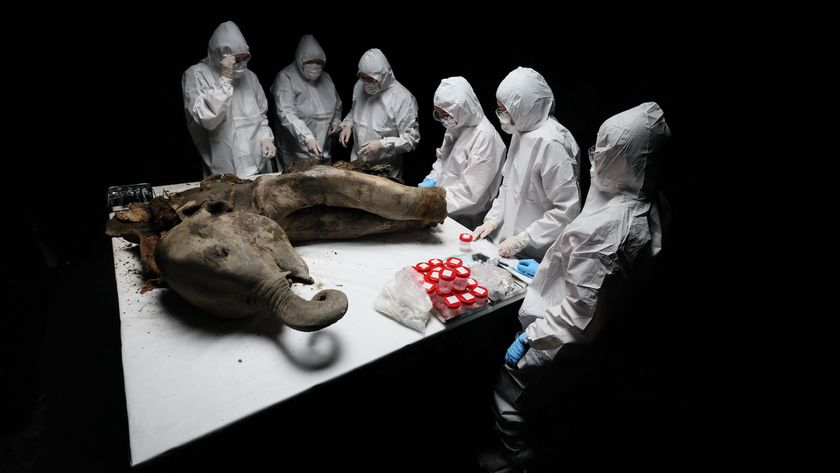Brute Force: Humans Can Sure Take a Punch

The human body can take a remarkable amount of punishment, given bones made of one of the strongest materials found in nature. At the same time, even an unarmed person can inflict an astonishing amount of damage with the proper training.
So how much does it take to crack a bone? And how much mayhem can a person deal out? In an era when "extreme fighting" has become a popular phenomenon, scientists are testing the extremes that athletes at the peak of their game can reach in order to help the rest of us.
"Understanding brain injury mechanisms all the way down to the cellular level will ultimately help everyone, not just athletes," biomedical engineer Cindy Bir at Wayne State University in Detroit explained. "If someone has a brain injury in a fall or motor vehicle accident, what we learn from athletes can help as well."
Bone is extraordinarily strong — ounce for ounce, bone is stronger than steel, since a bar of steel of comparable size would weigh four or five times as much. A cubic inch of bone can in principle bear a load of 19,000 lbs. (8,626 kg) or more — roughly the weight of five standard pickup trucks — making it about four times as strong as concrete.
Still, whether or not bone actually withstands such loads depends heavily on how quickly force is delivered.
"When you perform CPR, you can give chest compressions and not break any ribs, but if you apply the same amount of force quickly instead of slowly, and you can end up having rib fractures," Bir explained.
Force unleashed
Sign up for the Live Science daily newsletter now
Get the world’s most fascinating discoveries delivered straight to your inbox.
When it comes to unleashing force quickly, Bir and her colleagues investigated boxers and found they could generate up to 5,000 newtons of force with a punch, more than that exerted down by a half-ton on Earth's surface.
When it comes to kicks, "they can obviously generate more force, since there's more body mass behind it," Bir said. After looking at kicks from several different fighting styles, they found that experts could generate up to 9,000 newtons with them, equal to roughly a ton of force.
A quick, sharp blow that delivers some 3,300 newtons of force has a 25 percent chance of cracking an average person's rib, she said. It takes more force to fracture the femur, Bir noted — maybe some 4,000 newtons — since that long thighbone is meant to support the body.
"That doesn't means that below those values you won't have a fracture or above them you will," Bir said. The amount of damage a blow inflicts also varies due to factors such as the amount of muscle or fat covering a bone and the angle at which the blow lands, as well as the age and health of a person, which can affect bone strength.
Although it makes sense that a massive fighter can unleash more powerful blows than a lightweight, "it's also about how much of the mass of your body you can recruit," Bir said. "You see some little guys hit with a lot of force because they know how to recruit their mass."
Roll with the punch
When it comes to knocking someone out with a punch, "it's less about the force of the blow than it is getting the head to whip around, to move in a rotational kind of way," Bir said.
The shear forces from a strike that whips the head back stress out neurons, and the brain shuts down as a protective response. A blow that gives the head enough spin to go from 0 to 43,000 rpm in just one second has a 25 percent chance of knocking a person unconscious.
"That's why you see boxers build up neck muscles — the thinking is that you can prevent that kind of motion then," Bir explained. "It's also about anticipating the blow — the ones that catch you off guard can be more of an issue."
Knocking the wind out of someone is also less about force "than the impact occurring just right for it to happen," Bir said. When it happens, the air isn't literally squeezed from the lungs, but instead it is a matter of getting the diaphragm — the sheet of muscle under the lungs — to spasm.
"A blow can cause your diaphragm to temporarily lock up — it's kind of like a cramp, and so it's hard for you to take a breath," she explained.
Wading into a fight
It can be hard to study how much damage a person can really give or take.
"We try as best as we can to study athletes in their native environment, so to speak, so more time in the ring, or during bouts or fights the better — that's when they're really fighting to peak potential," Bir said. "It can be difficult integrating equipment into that environment to measure them, since you don't want to interfere with their normal functioning, such as sensors that might decrease the protective effect of their gloves. The nice thing is that technology is advancing and getting smaller and wireless, to not get in the way of what people are doing."
The data that Bir and her colleagues might glean could help save lives.
"We joke that if someone is willing to get hit in the head, we should be measuring it," she explained. "If we know what causes an injury, you can do simple things like develop better protective gear and design bike helmets to help, say, 7-year-olds."
- Fight, Fight, Fight: The History of Human Aggression
- Video: Slaps and Punches in Slow Motion
- The Science of Fighting












